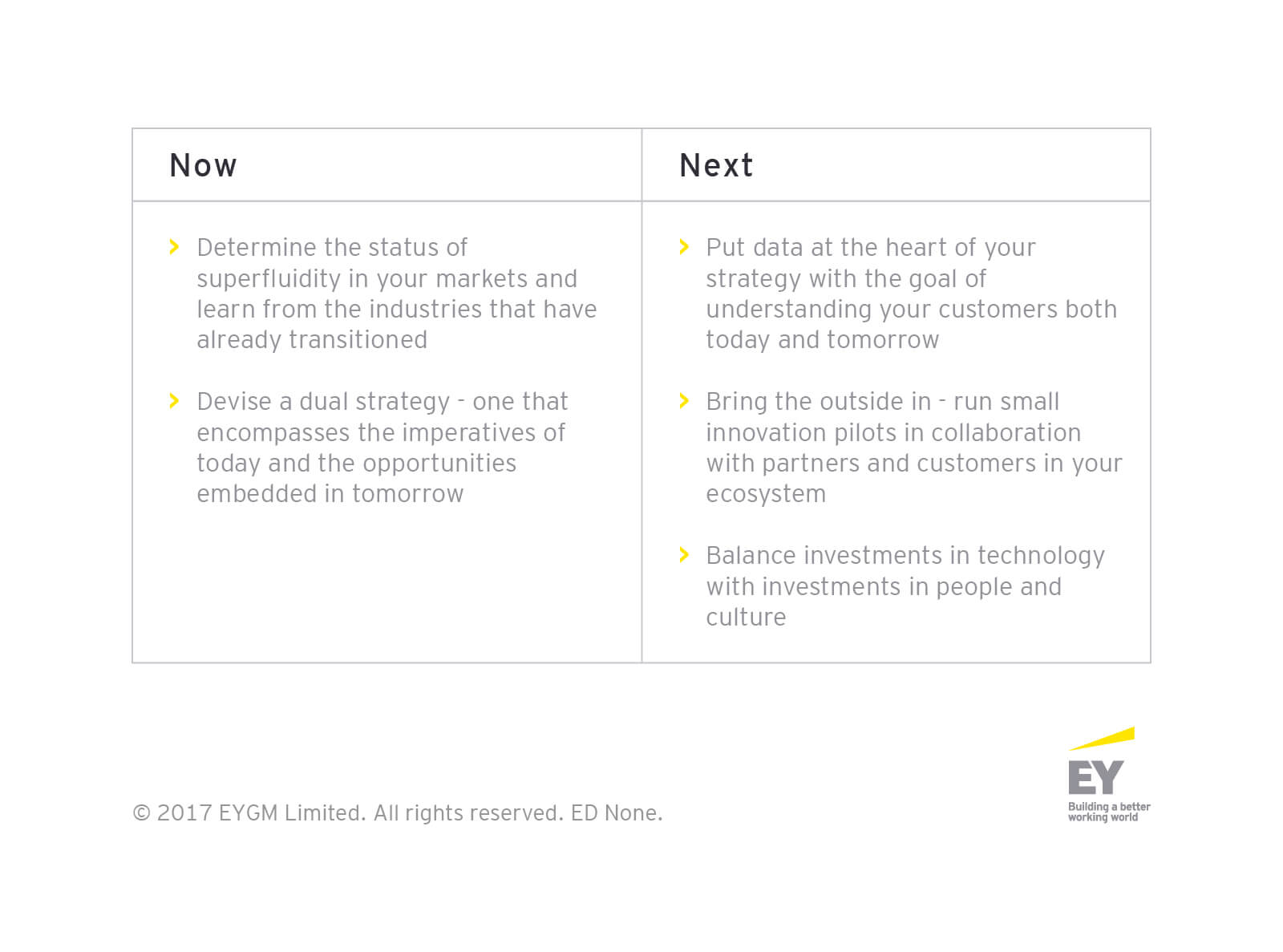
The path to success in the age of superfluid markets
So what can companies do to reposition themselves to create value? Here a few key steps:
- Build a different leadership profile.
Successful organizations will be those that are helmed by leaders who can steer through ambiguity. Leaders must be comfortable with taking risks and rethinking proven business models. At the same time, they must avoid innovating for innovation’s sake. Innovation should be closely aligned to a coherent strategy. But even strategy is not as simple as it once was. Given the exponential pace of digital change, organizations cannot develop strategies sequentially. Superfluid leaders must create and implement a dual strategy for operating in a global digital world — one that addresses the challenges of today while transforming the company based on a vision of the future.
- Balance what’s human with what’s automated.
Companies are investing in various intelligent automation solutions to meet key business objectives. As these technologies take root, company operating models will change. But the challenge is more nuanced than replacing humans with machines. Companies must consider how to integrate the work of humans and machines to the benefit of both the individual and the organization. Optimally, artificial intelligence should free humans from routine work and provide a powerful tool that augments human creativity, insight and imagination. That requires an environment where investments in culture are as important as those in technology.
- Data is the engine, trust is the lubricant.
Alec Ross, author of the New York Times bestseller The Industries of the Future, suggests that harnessing the power of data will be what moves companies from the fluid to the superfluid age. But he also highlighted the challenge: 90% of the world’s data has been created in just the last two years. At the same time, according to IDC, the total amount of digital data created worldwide will explode from 4.4 zettabytes in 2013 to more than 180 zettabytes (the equivalent of 180 billion terabytes) by 2025. More than anything else, the ability to get the right inputs, extract meaningful insights and translate outputs to action will drive tomorrow’s winning companies. But even as data is put to work, privacy concerns and trust remain major sources of friction for most marketplaces. From improved cybersecurity to blockchain solutions that verify transactions without a central authority, companies must put trust at the center of superfluid strategies.
- Customer-centricity.
As expectations of seamless interactions rise and traditional value chains become increasingly obsolete, maintaining focus on customers becomes a greater challenge. Who are your customers? And which customers do you listen to? Listening only to your core customers may mire you in stagnating business lines. That’s why it’s important to establish responsive customer networks that can quickly provide a diversity of feedback. Relentless focus on customers requires good data strategies and innovation excellence. This will help you not only understand who your customers are today, but who they might be tomorrow.
Your strategy must be aligned to the path of least friction. If not, you have a flawed strategy. And that’s where start-ups can help. They have laser focus on customers and many big companies have lost this.
- Build your ecosystem, find the right partners.
In a superfluid market era, no company can go it alone. Bringing the outside in has become the minimum requirement for businesses to compete. a table stake. Determining what is core and non-core to your business is an imperative. From an innovation perspective, large incumbents need exposure to speedy thinking. Corporate venturing and agile, low-risk pilots with start-ups in your ecosystem are ways to accomplish this.
- Learn from the industries that went first.
Industries are moving into the superfluid era at different rates. Those markets whose products were easily digitized became superfluid first. Now that the Internet of Things (IoT) is allowing physical goods to assume digital identities and become connected to the internet, new industries will be able to take advantage of superfluid market opportunities. Players in these sectors can learn from the early birds who have pioneered new ways for buyers and sellers to connect through private and open marketplaces, real-time bidding, and auctions and exchanges.
Maturing technologies like artificial intelligence, robotics, IoT and blockchain are ushering in an era of superfluid markets. However, companies need to be aware of the challenges, the primary source of which is human. These include political discontent, nativist economy policy, regulatory constraints and backlash to technology, all of which could impede the reduction in market frictions. Still the genie is out of the bottle. Companies should prepare for a superfluid future.
Action agenda

Generated by EYQ, an EY think tank that explores leading and emerging trends, focusing on “what’s after what’s next?”. Explore more insights from Innovation Realized 17 in Powering growth in a digital world.
Resumen
In an age of superfluid markets, survival will depend on creating new value and preparing for the impact of new technologies on humans.


